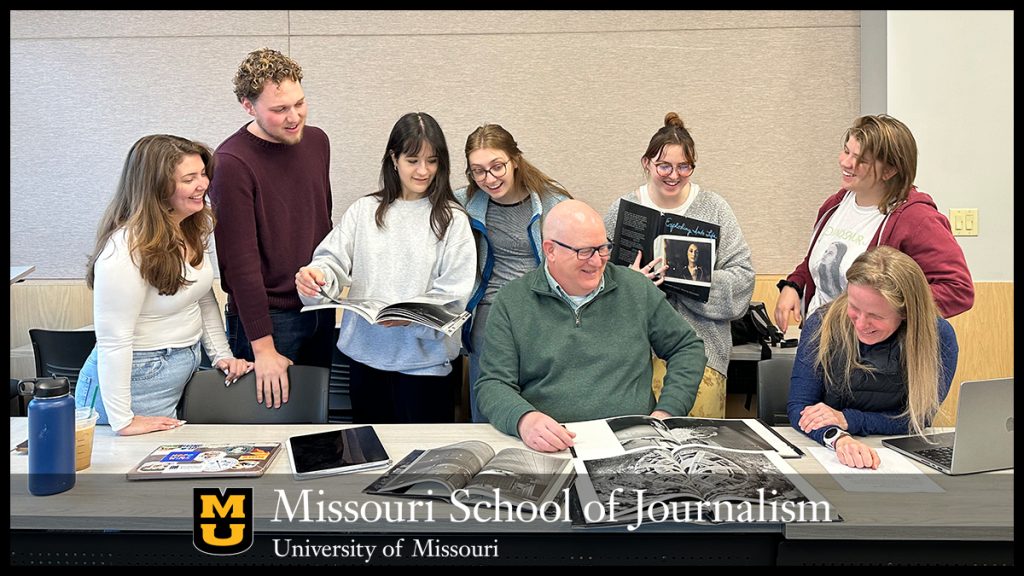Unearthing the stories beneath the images

Left to right: Megan Sundberg, Clayton Steward, Marisa Whitaker, Mallory Becker, Greenwood, Caroline McCone, Cleo Norman and Lisa Krantz.
Keith Greenwood’s work at the Missouri School of Journalism is still breaking new ground
COLUMBIA, Mo. (March 23, 2023) — Keith Greenwood wasn’t supposed to have a career in the field of photojournalism. He wanted to go into radio, perhaps photography’s most polar opposite in the world of storytelling, and thought he would eventually set aside the interest in images that had been with him since his earliest memories of wielding a camera on family vacations.
But if fate is a game of chance, Greenwood was playing with weighted dice.
“Every time it came to a decision point of setting photography aside as a hobby to pursue radio, something veered and photography was still there,” said Greenwood, an associate professor at the Missouri School of Journalism. “Finally, I said, ‘this is where I want to be.’”
Fittingly, then, his work as a photojournalism historian and researcher has tended to examine the genesis of things; how a batch of photographs, for instance, is whittled down to a single image on the front page of a newspaper.
“A big chunk of what I’ve looked at has been the finished product and what’s contained within that, but my approach tries to incorporate an understanding of how these things get done,” Greenwood said. “What is the process of photojournalism within a news environment, and what sorts of things affect the finished product? Why do we see what we see?”
And as the co-director of the McDougall Center for Photojournalism Studies, that same ethos is evident in his work to preserve and display photography collections. In regards to the center’s recent retrospective exhibition of National Geographic photographer Jim Richardson’s 50-year career, he has said the photographs are a lesson in “learning how to recognize what a story is and let it develop.”
Every time it came to a decision point of setting photography aside as a hobby to pursue radio, something veered and photography was still there. Finally, I said, ‘This is where I want to be.’
Keith Greenwood
Greenwood recognized his own story a while ago, but it is still developing; Since earning his doctorate from the School of Journalism in 2006 and becoming an assistant professor in 2008, the School has served as the darkroom where new dimensions of his work continue to reveal themselves.
“We’ve worked together on a research project that connects the current social justice movement with protest in previous generations,” said Earnest Perry, associate dean for graduate studies and research at the School of Journalism.
Their paper, “Connecting the long struggle: Reflections of iconic civil rights photographs in coverage of Black Lives Matter,” was presented at 2017’s American Journalism Historians Association conference in Little Rock, Arkansas, a city that has a prominent place in the history of the civil rights movement.
“Dr. Greenwood is one of the best scholars and teachers in our field, and we are very lucky to have him as a member of our faculty,” Perry added.
Last year, Greenwood co-authored a study revealing that a large portion of the public is unaware of the extent to which artificial intelligence is present in the news production process. Most recently, however, his attention has turned toward what he calls “conflict photography,” or the photojournalism that has documented wars and conflicts over the 200-year course of photographic history.
To that end, his grant-funded research into the history of military newspaper Stars and Stripes seeks to understand how the publication’s photographic coverage evolved over the course of struggles like the Vietnam War.
“Photographs can open vivid windows into the past, and Keith does much the same thing with his research,” said David Kurpius, dean of the School of Journalism. “Whether he is sharing his expertise in the classroom or poring over photo archives, his efforts enrich our understanding of photojournalism’s place in the communities it serves.”
But whether Greenwood is winning top-paper awards from the Association for Education in Journalism and Mass Communication or teaching students about photojournalism history and research methods, it’s the power of an image to communicate with viewers in a fundamentally journalistic fashion that excites him.
“What draws me consistently, historically, is the photographer’s ability to communicate something intimate about a person,” Greenwood said. “How people persevere, how their inner spirit can be reflected by how they are shown to us by a photographer.”
As for Greenwood’s inner spirit, discovering the decisions and processes that lay beneath the images we see in the news is only part of the equation. What ultimately gives his work lasting meaning is the opportunity to pass his insights on to new generations through his teaching, a philosophy that took root through his experience working with Tony Spina, who photographed for the Detroit Free Press for more than 40 years.
Greenwood only worked with Spina for a semester as a teaching assistant — during one of those “decision points” while he pursued a master’s degree at Michigan State University — but the experience left an impact that he hopes to emulate with his own students. “Tony never won a Pulitzer, but he trained three photographers who did,” Greenwood said. “That was fantastic to him. It’s the mindset of, ‘I don’t need to win this award — I want you to be able to win the award.’ If students have careers they are fulfilled by, then I’ve done my job.
Updated: March 30, 2023